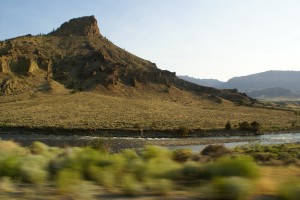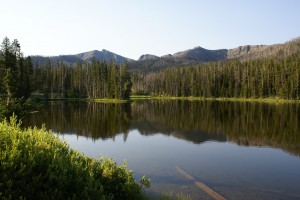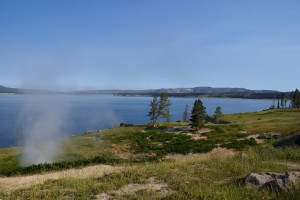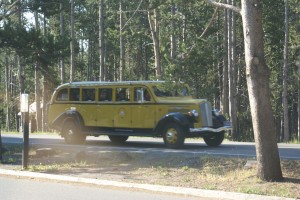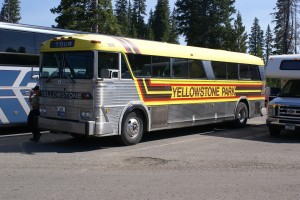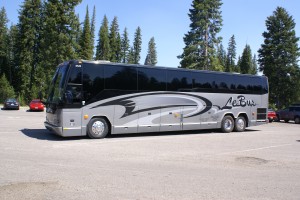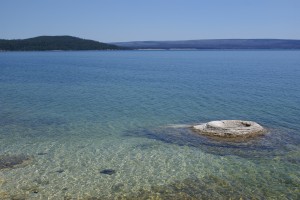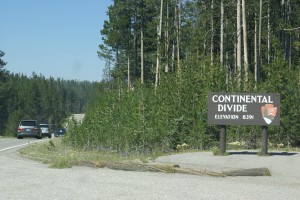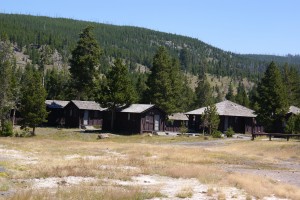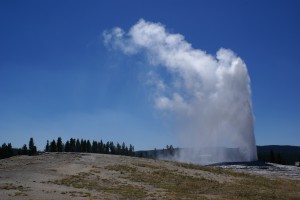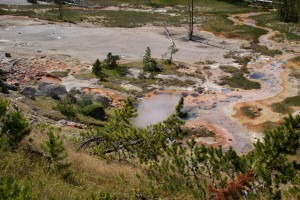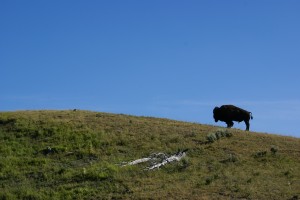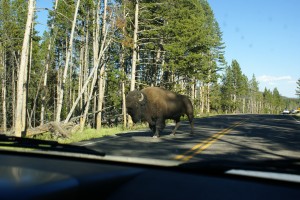We awoke this morning to temperatures in the mid 40’s. As we had no reason to rush we stayed under the covers a bit longer than usual. Lazy mornings are always a source of consternation for our cats who, in spite of the obvious presence of food in their bowls, expect us to get up at the first sign we are awake and attend to their perceived need for fresh(er) food.
I turned on the electric toe-kick heater in the bathroom to take the chill out of the air, but then decided to fire up the Aqua-Hot instead to warm up the entire coach and preheat the main engine. At a seminar in Gillette, Wyoming this past summer we learned that the Aqua-Hot needs to run with some regularity in order to run well, so this was an opportunity to do that and to check my work from yesterday for leaks. The Aqua-Hot ran quite well, but as I feared there was a small leak at the gasket between the two halves of the check valve. I will try one more time to get a couple of wrenches on this part and tighten it, but if that is not successful I will have to install the new check valve, which would take another entire day. Ugh. I like doing projects, but I don’t care so much for doing them more than once.
We had oatmeal for breakfast, which is always nice on a chilly morning and has a certain staying power for days when lunch is uncertain. After breakfast we got our coach ready for travel while Butch and Fonda did the same with theirs’. We departed Twelve Mile, Indiana a little before noon with Butch and Fonda in the lead and headed for Goshen, Indiana to attend the Great Lakes Area Motorcoach Association (GLAMA) 2013 area rally (GLAMARAMA13).
Our route was IN-16 (Co Rd 700 N) westbound to N Co Rd 600 E northbound to IN-25 northbound to US-31 northbound to US-6 eastbound to IN-15 where we stopped for a stretch break. We moved into the lead and continued northbound on IN-15 to Goshen with Linda navigating based on directions provided by the rally organizers. We had been advised by FMCA to follow the directions they provided in order to avoid a bridge that was out on the main road to the fairgrounds from the west.
We tend to travel on Intestate and US highways, but have also found State highways to generally be good for travel. Even county roads are OK if we know in advance we will not encounter weight, height, or width restrictions. This is where it is helpful to have local information from folks familiar with the roads. It also helps that our Rand-McNally RVND7710 GPS is configured to know the parameters of our rig, so we are able to travel with some confidence that we will not encounter unexpected obstructions. As an added feature it also provides real-time traffic information, especially near larger metropolitan areas.
The trip up IN-15 brought us quickly into the outskirts of Goshen with heavy, slow traffic. This presented a challenge for us as the buses do not accelerate that quickly and the lights do not stay green for that long. It was important that I not lose Butch at a light as Linda had the detailed directions for getting to the fairgrounds. As we came to downtown Goshen there was construction with lanes closed and traffic rerouted through barrel lined jiggy-jogs. We pressed ahead none-the-less as we needed to go east on IN-4, just three short blocks beyond the construction. We made it through but it was the kind of situation that adds a bit of stress to the usual pleasure of driving the coach.
We continued east on IN-4 looking for Co Rd 29 southbound. Along the way we spotted an official looking sign that said “RV Rally and Fairgrounds” with an arrow pointing down a nicely paved road to the south. I slowed down and considered taking this road—even though the turn looked a bit tight—until I noticed the “NO TRUCKS” sign on the adjacent pole. We are never sure whether or not we are a “truck” so we generally decide one way of the other depending on what is to our advantage. In this case I took a “pass” and continued on down IN-4 to CR-29. We headed south on CR-29 until it ended at CR-34 where we turned westbound back towards the fairgrounds. Our directions said to enter at Gate 3, but as we approached the northeast corner of the fairgrounds an orange-vested parking crew member motioned us to turn in. I hesitated again, but decided to follow his directions. The parking procedures are usually well thought out and the crews usually know what they are doing. The whole arrival/parking experience generally goes much more smoothly if you simply follow their directions.
(It is worth noting, however, that as with a boat or airplane the driver of an RV bears the ultimate responsibility for it’s operation and is the ultimate decision authority with respect to that operation. If the driver is unclear or uncomfortable with what parking crew are asking them to do, the correct response is to STOP, ask for clarification, and not move until they are certain they understand where they supposed to go and are comfortable (willing and able) going there. Arguing with parking crew, however, is counterproductive, and ignoring them and moving the RV is potentially dangerous. Parking crew are there to move large numbers of RVs efficiently and safely to planned parking areas and drivers should always give them their full cooperation but never surrender their ultimate decision authority.)
We arrived at the rally venue a little before 2 PM. The usual procedure is to unhook a towed vehicle and drive it, separate from the motorhome, to the site or a designated parking area. And so it was today. They had changed the entrance gate to channel us into an area where there was more room to unhook our towed vehicles. With the cars unhooked, we proceeded to the holding area where we queued up and waited to be escorted to our site. For this rally parking areas had been reserved for chapters so they could park together without having to arrive together (caravaan style). We were part of the reservation for the Great Lakes Converted Coaches chapter (GLCC). The parking crew was friendly and efficient and we “wheels down” (an aviation term) in our site by 2:30 PM with the coach set up and ready to use by 3:00 PM.
The reserved parking was an unusual feature of this rally, and an attempt by GLAMA to be as accommodating as possible in spite of the added complexity of this arrangement. If you have not been to an RV rally, you won’t fully appreciate how nice it was to be able to park with “our group” without having to coordinate our arrival with everyone else. Generally if RVs want to park together at a rally they have to arrive together in a caravaan. The only aspect of their parking that is usually pre-arranged is the area of the facility they will be in based on the hookups (electricity, water, sewer, generator use) they have paid for as part of their pre-registration. Even with a small number of RVs caravaning can be a challenge. Wile some rallies provide an arrival area where RVers can meet up and form their caravan, many rallies do not have the space for this. In that case, the RVers first have to find a place to rendezvous. (Walmart is a popular choice, especially if folks are staying overnight there anyway.) They then have to make their way to the rally site while trying to keep the group together at stop lights (which isn’t possible with more than two rigs). GLAMA is to be applauded for trying this new approach.
Goshen is the county seat for Elkhart County, Indiana and the home of the Elkhart County 4-H Fairgrounds. We had been to this facility once before for The Escapees RV Club Escapade in September 2010 and it is a nice facility for an RV rally. Access to the fairgrounds is good, and the interior roads are more than adequate for large motorhomes (and converted buses). The campgrounds can provide 30 Amp power and water for a large number of rigs (800+), and there are also some full hookup, 50 A sites. There are many buildings and covered outdoor areas available for entertainment, vendors, seminars, and meetings. And yet all of this is neatly contained in a surprisingly compact space that makes the venue very walkable while the paved roads make for good driving of toads and courtesy transportation golf carts.
This is the first Great Lakes Area Motorcoach Association (GLAMA) rally being organized by the officers and volunteers of GLAMA. For many, many years the Great Lakes Area Spring Spree (GLASS) rally had served this purpose. Held at the Berrien Springs, Michigan youth fairgrounds, GLASS was a nice rally at a nice venue held over Memorial Day weekend and consistently drew 800+ motorhomes until the last few years. Unlike most FMCA area rallies, however, the GLASS rally was organized by the Michigan Knights of the Highway, the 4th FMCA chapter ever formed, and the oldest FMCA chapter still in existence. MKH handled the registration process, and any financial benefit (or loss) went to them, not GLAMA.
GLAMA takes in Indiana, Michigan, Ohio, and Ontario Canada, so obviously it does not include all of the states that border on the Great Lakes. Even so, it covers a large geographic area with lots of FMCA members. GLAMARAMA 2014 is also slated for the Elkhart County 4-H Fairgrounds in Goshen, but the intent is to then rotate it to each state and Ontario for two years each. That will entail more work for GLAMA organizers, but will open up the chance for more people to attend and build a stronger sense of ownership across the association.
Today was early entry day, so there were no official activities beyond arrival and registration/check-in. Pat and Vicky Lintner were already parked at the GLCC area as Pat is the GLAMA VP for Indiana and part of the rally organizing committee responsible for all of the rally specific signage. We pulled in next to Pat and Vicky, followed by Butch and Fonda. Mike and Laurie Minnick pulled in shortly thereafter in their 1968 MCI MC-7 bus conversion. Don and Sandy Moyer then arrived in their 1948 Spartan bus conversion.
[Note: The Spartan bus was built for three years, post World War II, in Sturgis, Michigan. The owner/president of the company was the chief test pilot for the B-25 bomber. All of the engineers and craftsmen came from the aircraft industry and the bus was designed/built much more like an airplane than a motor vehicle. Only 57 Spartan buses were built and most of them ended up being used outside the U. S., including some used to make a 12 hour daily run from Damascus, Syria to Baghdad, Iraq and a 12 hour run back, making it the fastest bus line in the world at the time. The Moyer’s bus was the last one built, a 28 foot model. It was destined for a bus company in Wisconsin but they never took delivery. It left the factory as a seated coach, was driven out of the factory, and the front tires came off the ground because it was too heavy in the rear end. Within two years someone had purchased it, taken out the seats, and had it converted to a motorhome. Many of the details suggest that it was “professionally” done, but the Moyer’s have not been able to track down who did the conversion. It was eventually parked and left to rot for 35 years until Don and Sandy rescued it. Based on their research there are no more than 12 of the original 57 buses still in existence and theirs’ is almost certainly the only motorhome. Don worked 8 hours a day, 7 days a week, for 18 months to put it back in usable condition. It is a truly unique RV.]
GLCC reserved space for eight motorhomes and the other three planned to arrive tomorrow. The chapter will have more members/rigs in attendance than that, but they will be parked elsewhere. George and Sue Myers are parked within close sight of our group, but are located for their convenience in running the golf cart courtesy transportation service. Don and Kathy Crawford from Ontario are in the VIP row as Don is a past president of GLAMA, which also entailed being the national vice-president representing the Great Lakes Area. Ditto for Jon and Sondra Walker, who was the GLASS National Director until he moved on to become GLAMA President. Jon was elected the FMCA Senior National Vice-President this past summer at the FMCA national convention in Gillette, Wyoming, so the number two national FMCA officer is a GLCC guy. Ron and Meredith Walker, who just joined our chapter, are also here but are parked with the Frustrated Maestros. Ron is a retired K-12 music teacher and is the conductor of the FMs.
Linda made something new for dinner: firm tofu slices pan fried with onions and Bar-B-Que sauce. She served it on a sesame seed bun with a side of sweet corn on the cob and some Sam Adams Cherry Wheat beer to wash it down. Sometimes simple is best.
